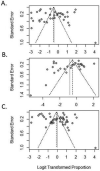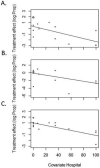This is a preprint.
Prevalence of Chemosensory Dysfunction in COVID-19 Patients: A Systematic Review and Meta-analysis Reveals Significant Ethnic Differences
- PMID: 32587993
- PMCID: PMC7310651
- DOI: 10.1101/2020.06.15.20132134
Prevalence of Chemosensory Dysfunction in COVID-19 Patients: A Systematic Review and Meta-analysis Reveals Significant Ethnic Differences
Update in
-
Prevalence of Chemosensory Dysfunction in COVID-19 Patients: A Systematic Review and Meta-analysis Reveals Significant Ethnic Differences.ACS Chem Neurosci. 2020 Oct 7;11(19):2944-2961. doi: 10.1021/acschemneuro.0c00460. Epub 2020 Sep 17. ACS Chem Neurosci. 2020. PMID: 32870641 Free PMC article.
Abstract
A significant fraction of people who test positive for COVID-19 have chemosensory deficits. However, the reported prevalence of these deficits in smell and/or taste varies widely, and the reason for the differences between studies is unclear. We determined the pooled prevalence of such chemosensory deficits in a systematic review. We searched the COVID-19 portfolio of the National Institutes of Health for all studies that reported the prevalence of smell and/or taste deficits in patients diagnosed with COVID-19. Forty-two studies reporting on 23,353 patients qualified and were subjected to a systematic review and meta-analysis. Estimated random prevalence of olfactory dysfunction was 38.5%, of taste dysfunction was 30.4% and of overall chemosensory dysfunction was 50.2%. We examined the effects of age, disease severity, and ethnicity on chemosensory dysfunction. The effect of age did not reach significance, but anosmia/hypogeusia decreased with disease severity, and ethnicity was highly significant: Caucasians had a 3-6 times higher prevalence of chemosensory deficits than East Asians. The finding of ethnic differences points to genetic, ethnicity-specific differences of the virus-binding entry proteins in the olfactory epithelium and taste buds as the most likely explanation, with major implications for infectivity, diagnosis and management of the COVID-19 pandemic.
Conflict of interest statement
Conflicts of Interests
The authors have declared no competing interests.
None of the authors have any proprietary interests or conflicts of interest related to this submission.
Figures






References
-
- Bagheri SHR, Asghari AM, Farhadi M, Shamshiri AR, Kabir A, Kamrava SK, et al., Coincidence of COVID-19 epidemic and olfactory dysfunction outbreak. MedRxiv preprint. https://www.medrxiv.org/content/10.1101/2020.03.23.20041889v1 - DOI - PMC - PubMed
-
- Beltrán-Corbellini Á, Chico-García JL, Martínez-Poles J, Rodriguez-Jorge F, Natera-Villalba E, Gomez-Corral J, et al. Acute-onset smell and taste disorders in the context of COVID-19: a pilot multicentre polymerase chain reaction based case-control study [published online ahead of print, 2020 Apr 22]. Eur J Neurol. 2020; 10.1111/ene.14273. doi:10.1111/ene.14273 - DOI - DOI - PMC - PubMed
-
- Bertlich M, Stihi C, Weiss BG, Canis M, Haubner F, Ihler F. Characteristics of impaired chemosensory function in hospitalized COVID-19 Patients. Preprint in SSRN. 10.2139/ssrn.3576889 - DOI
Publication types
Grants and funding
LinkOut - more resources
Full Text Sources
